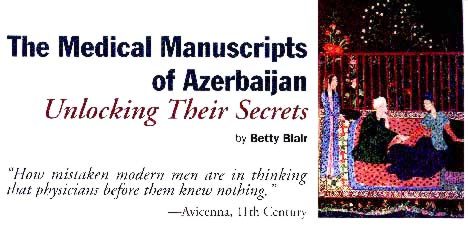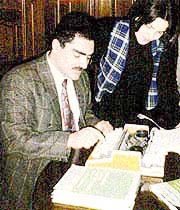|
Summer 1997 (5.2) 
How do you treat a headache? Do you reach for a bottle of aspirin? Get some fresh air? Take a nap? Three hundred years ago, Azerbaijani physician Mohammad Yusif Shirvani would have advised you to stop and smell the roses, literally. The fragrance given off by roses was believed to alleviate headaches. Other early physicians might have suggested eating eggplant or listening to birds sing. Some might have even written down a magic charm to place under your pillow. How do we know about these medieval remedies? The Institute of Manuscripts of the Azerbaijan Academy of Sciences in Baku has a collection of 390 early medical documents which include 363 manuscripts dating from as early as the 9th century. Most are written in Arabic-the literary script of the day. Of these, 70 are in the Arabic language, 71 in Turkic languages, and the remainder in Persian. Biomedical Historian Farid Alakbarov, 33, has devoted much of his academic career to studying these early handwritten documents, hoping to recover some of their ancient wisdom and enabling them "to speak" to the modern world. He has been working at the Institute since he graduated from the Biology Department of Baku State University in 1986. But his job has not been easy. The mere fact that Azerbaijan has officially changed alphabets four times this century-from Arabic to Latin (1929), Latin to Cyrillic (1939), and Cyrillic back again to Latin (1991) has made these traditional medical treatises even more difficult to decipher. Knowledge that was accessible to all literate Azerbaijanis a mere 70 years ago has become quite esoteric these days. In addition, during the transitional period in the Turkic-Soviet republics when the Latin alphabet was being adopted, systematic and brutal campaigns were carried out to eradicate everything associated with the Arabic alphabet primarily because of its identification with Islam. Azerbaijanis who are 80 or older can personally recount being forced to gather books and toss them onto bonfires, whether or not the content was religious. Consequently, many manuscripts, including those related to medicine, went up in flames. Such purges are incredible losses to science today, not only in Azerbaijan but throughout the world.
Farid's curiosity about the Arabic script began when he found an old book which had belonged to his great-grandfather lying around the house. it was a collection of Azerbaijani poems by the satirist, Sabir, handwritten in the Arabic cursive script. Somehow, Farid managed to find the same poems in Cyrillic and started comparing the two scripts. He was about 10-years-old at the time. Neither of his parents knew how to read Arabic. It was Farid's grandmother who would unlock the secret code for him. Later, Farid would study both the Arabic and Persian languages at the university. Most of his classmates studying these languages were interested in literature, history or philosophy. But Farid was drawn back into another one of his childhood interests-science, especially biology. Both his mother and father are biologists. He was particularly fascinated when his father would return home from international symposiums and discuss current scientific issues. It was only natural that Farid would combine these two loves and end up concentrating on Azerbaijan's history of medicine and biology. But Farid is the first to admit that mastering these regional languages along with their scripts is not sufficient to unravel the mysteries of medieval medicine. "First of all, you have to get used to many different handwriting styles." He should know. His doctoral dissertation explored 47 of them. He has also referred to them in some of his other works: "Comparative Analysis of Medicinal Herbs of the Middle Ages and Contemporary Azerbaijan" (Russian), "Treatment Methods Used in Medieval Azerbaijan" (English), "Eastern Medicine and National Azerbaijan Cuisine" and "Sherabname" or "Book of Wines" (Azeri). But even more difficult than deciphering scripts is identifying terms for plants, ailments and medical concepts. Through the years, as medical information was collected throughout this vast region, the same concept was often identified by numerous terms. Naturally, as the body of scientific knowledge grew, theories and the accompanying terminology developed and changed, as well. Farid has discovered that the broader one's scientific base, the greater one's chances of comprehending the meaning of the texts. Medical history, he insists, requires fundamental knowledge of pharmacology, mineralogy, zoology, biology, botany and other related disciplines. Farid notes that Eastern medicine emphasized preventative medicine. Generally, the manuscripts in the Institute's collection focus on three areas-prevention, treatment and pharmacology. Usually, palace rulers commissioned such manuscripts, and a few hundred copies were issued, all by hand. Farid notes that those in the Turkic languages tend to be encyclopedic, but at the same time, concrete and brief. They also tend to be more practical than theoretical, and drawn from a variety of sources including Indian, Chinese, Arabic and Greek schools of medicine. Traditionally, no part of a medicinal plant was wasted; all parts were used-seeds, flowers, leaves, stems and roots. But these early manuscripts reveal that medicinal plants were not the only way to treat disease. Physicians of the period were also familiar with surgery. For example, archeological evidence indicates that trepanning of the skull was done in 4,000 B.C. They were also familiar with aroma therapy, which is becoming more and more popular in the West today. The smell of quince, for example, was believed to strengthen the natural energy of the body. Citron was used to tone the nervous system, and apples, to stimulate the brain. Music was also recognized as another form of therapy because of its ability to affect emotions. Positive effects were observed when people listened to music or to birds singing, especially the nightingale. Even listening to someone recite poetry was viewed as curative. Mahmud ibn Ilyas (12th century) recommended that insane, tired and high-strung nervous types be treated with Azerbaijani mugam music. "Such a patient should be made to lie down in a comfortable place, preferably near a flower garden next to a fountain of running water. If someone sits next to him and performs tender melodies on a stringed instrument, the effect is even stronger. Eventually, the patient will relax and fall asleep." Medieval doctors cautioned people not to get tired. Working to exhaustion and then trying to compensate by sleeping longer was viewed as harmful. Instead, frequent short breaks were recommended. Emphasis was placed on a balanced harmony between work and rest. Even color entered into the treatment of some physicians. The 18th century text "Tibbname" suggests that one's place of rest be decorated in flowers and painted in pale blue, green or white tones. Many physicians strongly warned about the overuse of animal fats. In the 17th century, Mohammad Momin wrote that "animal fats are bad to digest and may cause sickness and vomiting. So, whenever possible, vegetable oils should be substituted." He went on to list the consequences of eating animal fats including stupefaction, poor memory, heart disease, weak eyesight and epilepsy. In order to counter these effects, sour substances should be incorporated into meals to help breakdown meat more effectively during digestion. He recommends vinegar, lemon, pomegranate, unripened grapes and various spices such as fennel, saffron, cardamom, cloves and cinnamon, which have the ability of stimulating the gastric juices and making digestion more rapid and complete. The Manuscript Institute is fortunate to have some real treasures in their collection. For example, they have one of the oldest copies of "Canon of Medicine" (1030) by Ibn Sina, known in the West as Avicenna (980-1037). It was copied in 1142 about a hundred years after his death. Avicenna, born in Bukhara (Uzbekistan), did much of his medical observation later on in Persia. "Canon," an encyclopedic work in Arabic, is considered to be the single, most famous book in medical history-both in the East and in the West. Some of the most fundamental Azerbaijani works in the Institute's medical collection include: Mahmud Ibn Ilyas' 14th century work, entitled "About the Science of Treatment" ("Quiyasiyya"), is a comprehensive, 1200-page book describing fundamental ideas about medicine, symptoms and causes of specific diseases, and treatments. Ilyas gained his experience while living in Tabriz and Shiraz, and traveling to many different Eastern countries. Azerbaijani scholar Yusif ibn Ismayil Khoyi (also known as Ibn Kabir) worked as a doctor in the palaces of the Arabian caliphs in Baghdad. He is known for his comprehensive pharmacology written in Arabic in 1311. Several thousand medicinal herbs are identified in "The Necessary Things For a Doctor So As Not To Increase His Ignorance" ("Ma la yasa al-tabib jahlahu"), often referred to by its shortened title "Baghdad Collection" ("Jami-al-Bagdadi"). Mir Mahammad Momin, a palace physician for Suleyman Safavi, wrote many informative works in Persian including "Tohfat al-Mominin" (1669). This encyclopedic work includes the names of more than 4,000 herbs, animals, minerals and other ingredients used in medicine. Momin describes the name of each herb, its specific features, where it can be collected, other regions where it is available, and its names in other languages, such as in Chinese or Hindi dialects. The Institution owns 33 complete manuscripts and 4 fragmentary copies of this work. Muhammed Yusif Shirvani's "Tibbname" ("Book of Medicine") was written in Azeri in 1712. A palace physician for the Shirvan Shahs, Shirvani recommends using natural materials to treat symptoms, such as rubbing a piece of lemon peel against your neck when tired. Shirvani also describes more complicated drugs, as well as uses for "non-indigenous" plants in the region such as potatoes and sunflowers. In the 13th century, Nasreddin Tusi wrote an extremely enlightening book entitled "Mineral Cures" ("Tansukh Name") which identifies the symptoms of a disease and possible treatments via minerals. These are identified by color, as well as region. Farid is always quick to add a disclaimer about all early medical beliefs; he insists such recommendations need to be investigated scientifically before being applied. On the other hand, he feels they provide a great deal of useful information from which modern man may benefit. So much investigation remains to be done. And so few medical historians are currently involved in such research. Out of 726 medicinal herbs that were mentioned in these early manuscripts, only 466 are known to grow in Azerbaijan today. Of these, 252 are not currently being used for any medicinal purpose, at all. Farid regrets that not as many young people are attracted to science in Azerbaijan as in years past. Such research requires economic support-financial barriers are a great detriment. "Scholars today have to occupy themselves with so many things other that research just to survive. It's too hard to concentrate on academic projects under such circumstances." He also admits that not everyone is "cut out" for such work. A person has to have an analytical mind to do such research. "You have to be born a researcher, just like you have to be born a poet or an artist," he says. But the world would certainly benefit from knowing the hidden secrets of these manuscripts, according to Farid. "You have to remember that modern medicine is only a few hundred years old. Traditional medicine is the accumulation of millennia." In the meantime, Farid has just
finished preparing a book in Azeri Latin for kids from ages 6-10.
"Science in Tales" includes 30 different concepts such
as photosynthesis, symbiosis, immunity, parasitism, viruses,
DNA, RNA and mitochondrion, which are explained in a fairy tale
format. Farid hopes to publish this book soon, so that even more
children might be enchanted by the marvels of science. Back to Index
AI 5.2 (Summer 1997) |

